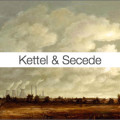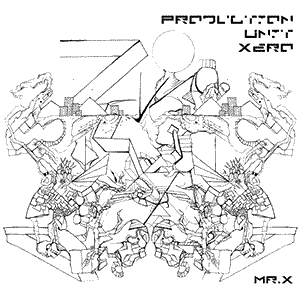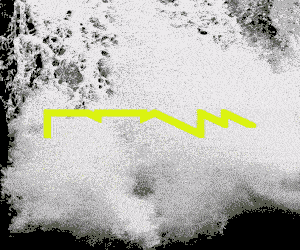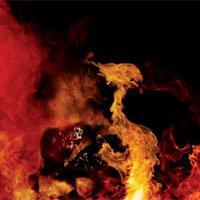
(Feb: 2005) SEVERAL years ago, I attended a Ryoji Ikeda / Dumb Type concert at an
upscale art theater in Seattle. In the lobby was a large wicker
basket filled with disposable ear plugs and a sign that said, “Really,
you might want a pair for this show.” Most of the well-heeled ladies
and their servile gentlemen stood around the basket, sipping wine from
plastic cups and talking about how cute the tiny souvenirs were. The
show opened with a single sonar ping, a bell tone that filled the room
and focused our attention on the stage. Three minutes later, the
first spine-rattling blast of noise struck the audience and, in the
echoing aftermath of its passage, all you could hear in the theater
was the panic of the audience as they frantically worked the earplugs
out of the plastic sleeves and into their ears.
Like Ryoji Ikeda, Darrin Verhagen does soundtracks for performance
pieces and the howling fury of his Medea soundtrack makes me wonder
how many audience members died from fright on opening night. Based in
Australia, Verhagen conducts suites of orchestral terror and creates
collages out of the collective noise of our existence. Recording
under a number of monikers — names like Professor Richman, Shinjuku
Thief and Shinjuku Filth that attempt to convey the mood or the
thematic thrust of the project — Verhagen’s fascination with sound
sweeps across a broad range of styles: industrial dance, gothic
orchestral, dark minimalism, performance cut-up, and mutant Fourth
World soundscapes.
The Dorobo label, created as a way to release Verhagen’s work to the
wider public, has recently stopped producing CDs (“It was either him
or me,” Verhagen jokes), allowing Verhagen more time to focus on the
music. The last release on the label is the black | mass box set, a
featureless onyx slab that contains three CDs — one by each of
Verhagen’s realized personalities. Coupled with a tangential
collection of music done for an unreleased video game and a new
Shinjuku Thief record for Sweden’s Fin de Siecle Media, as well
as an upcoming
mini-tour of Europe (culminating in a night of dark sonic mischief
with several of the luminaries from the Cold Meat Industry roster),
now is a grand time to discover the tribal mischief and minimalist
soundscapes of Darrin Verhagen.
Contributing Editor Mark Teppo catches up with Darrin Verhagen shortly
before his departure to Europe for the tour and gets in a quick round
of Q & A about the past, present, and future of Verhagen’s rhythmic
noise orchestrations and dark ambient soundtracks.
::..:::…..:..::….:::::..:::..:::::::……:::…::.:::….::::..:..:::…::…….:::::
Igloo :: Having only heard the soundtracks to the performance art
pieces that you’ve done, I’ve had to imagine how the dancers
interpreted your classical and chaotic noises. Are those projects
where you score a realized performance or have they been collaborative
pieces where you interact with the choreographer and/or director about
the end result? Did the performers of Medea have any idea what they
were getting into?
Verhagen :: Usually it’s a pretty collaborative process. I may well
provide some preliminary sketches in the rehearsal room at the outset
(based on conversations I’ve had with the choreographer) but these are
ultimately finessed (detailed or stripped back/pushed out or made more
conservative) and informed by what I see. Given the organic nature of
that process, the dancers are never too shocked or brutalized by what
I present (with the possible exception of parts of my Hydra score).
With Medea, I had told the director from the outset that I wanted the
territory to be bordered by the sonic triangle of Chion’s Requiem,
Merzbow and Diamanda Galas, so I’d say he was prepared. The more
traditional and musically arcane components in the score were written
to provide a solid touchstone for what was originally going to be a
very experimental production. As the play ended up bring written
*after* much of the score, and the tone and form of it changed from
that initial conception towards something more play-like, I probably
would have made the soundtrack more cut up and brutal if I’d known…

Igloo :: The first part of the Witch Hunter trilogy, The Witch Hammer,
was based on the Malleus Malificarium, a 15th century treatise on how
to identify and deal with witches. Is there an expectation that the
audience will know the reference or is it simply an anchor on which to
hang the thematic structure of the orchestrations? Did the Malleus
Malificarim influence the entire trilogy or were there other
influences?
Verhagen :: Whilst the Malleus Malleficarum provided a central thread
for the trilogy, the territory is so rich, one only needs to set up a
loose frame (“witchcraft and the supernatural”) for the audience’s
imaginations to do their work. Given that the albums aren’t adding to
the understanding of the book (ie. the music hardly qualifies as a
discussion of ideas — indeed, my interest was more in the
historical/political than the supernatural) a prior knowledge of the
text isn’t a prerequisite. I think it’s probably necessary to
separate out the musical from the conceptual influences on those
works. For whilst the frame is provided by the text, the initial
impetus for writing “The Witch Hammer” came from a musical interest in
employing a hip-hop approach to construction, whilst using a classical
sound palette. So if anything it was the exploration of that idea
(inspired by albums such as FM Einheit’s Steinzeit) which was the
primary impetus, with the conceptual thread providing some sort of
narrative justification for the listener.
Igloo :: You released the Soft Ash record under your own name. It was
a thematic record based around “atmospheric inversions” and was a
collection of extremely minimal spooky ambience built from, among
other things, the sound of you scraping out a pumpkin. How do you go
about collecting and utilizing found sounds?
Verhagen :: Sadly, I’m not in a position to outline a particularly
rigorous and methodical approach! My fellow lecturer at RMIT
University, Philip Samartzis, would have a far more ordered response.
I record material as needed, and have access to recordings from others
working in the field (particularly the film industry), but it can be
fairly chaotic/indeterminate as to what gets used where and how. From
there, it just depends on the project as to how preciously I attempt
to preserve the integrity and identity of the recording, c.f. how far
I might abstract it in the service of the piece. Notwithstanding the
examples of overt (filmic) sound design, generally, I’ll be
positioning most of the non-musical material as ‘sound objects’ —
where knowledge of the source is an unnecessary hindrance to an open
‘reading,’ and the audio is merely selected for its timbral, rhythmic
and/or structural properties. (The actual identification of the
pumpkin source on Soft Ash simply continued that CD’s gentle ribbing
of concept albums cloaked in academic conceit!)
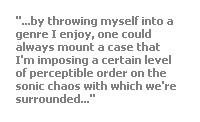
Igloo :: Shinjuku Filth seems to be a collage-inspired identity and the
Shinjuku Thief persona is more inclined towards cinematic
orchestration. I read somewhere that “Dorobo” is a Japanese word that
means “thief” and that the origin of the band names is a 1960’s
experimental Japanese film, Oshima’s Diary of a Shinjuku Thief.
While slightly disparate in style, these two identities seem to be
your core personas. Are they experiments in finding order in the
sonic chaos which pervades modern human existence or is the allure the
broad musical strokes these projects afford you?
Verhagen :: I think, primarily, it has to be the latter — although by
throwing myself into a genre I enjoy, one could always mount a case
that I’m imposing a certain level of perceptible order on the sonic
chaos with which we’re surrounded. Both projects probably say more
about the genres from which they draw inspiration than ‘real (sonic)
life’ though.
Igloo :: The creation of the Dorobo label came out of the reaction from
the reactions to The Scribbler, your first Shinjuku Thief record, and
the comments that it was either “too classical” or “too industrial.”
Do you think audiences still have this sort of gut-level reaction to
works or are listeners becoming more open to cross-genre experimental
works (or is the level of awareness about them just rising)? Do you
find that the commissioned work you’ve done for specific audiences
(theater, dance companies, radio) have a more open listening base than
traditional record listeners?
Verhagen :: I think the audiences for dance works are probably less
surprised by cross genre pollination. One could mount a case that this
stems from their exposure to a broad range of styles, leading to a
greater musical sophistication. One could also argue it’s because they
don’t pay attention to the music when watching a dance work, so none
of those issues register! I think we live in an interesting time when
it comes to the consumption of music. I know people who make active
use of the shuffle function in their iPods, to deliberately throw up
strange juxtapositions of genres, better presenting the
relationships/clearer contrasts between disparate forms. I’m sure the
mp3 culture (with its ease of access to material) has also helped
people explore styles they may have never considered previously, as
much as it may have allowed others to simply hammer themselves further
into a narrow field. I think there’s always going to be a particular
level of tribalism with which people identify and propagate at the
centre of particular genres (and ‘classical’ and ‘industrial’ are
possibly more precious than others) — but I think through wider
exposure and access, there’s a better chance to break that down now
than there has been at any other time in history.
The points at which rock/pop music eats and regurgitates its own
history are also worth noting. Whilst such a process has always been
with us, it’s never been more blatant than it is at the moment. If you
wanted to claim that it’s vapid and creatively bankrupt, the process
can be viewed as an act at the expense of imagination; conversely, you
could also argue that, at its best, it’s actually forging a more
consolidated series of interesting links across time and space. How
the listener responds becomes the litmus test, I guess.

Igloo :: What comes first: the name you’ll use for a project or the
project itself? Does the realization of “Oh, this is a Filth record”
change or modify your plan or is that the cohesive moment when you
realize the record’s ultimate shape? How different is the listener’s
approach meant to be for the various identities or are they just
marketing distinctions?
Verhagen :: Ultimately, they’re just marketing decisions, to give the
audience some indication as to what style has been employed. As a
composer, I’d always been happy to see Shinjuku Thief move across
genres, without regard for any of the consequences. In my role as
record label manager, and in the light of some initial tribal
resistance/lack of openness from audiences it became more important to
project a better level of clarity in this regard. I certainly never go
into the studio wearing either a ‘Filth,’ Thief,’ ‘EPA’ or ‘Verhagen’
cap. Although once a project is underway in a particular direction,
the understanding of that style will certainly influence the decisions
I make.
Igloo :: How does your process work? Do you build your music from the
individual elements like an oil painting or do you chip away at an
edifice like a marble sculptor until you find the shape you like?
Verhagen :: It depends on the work. Both my densely layered Shinjuku
material and my more austere electro-acoustic pieces employ an almost
obsessive level of detailing. But after building up the piece, like a
painting, this crafting extends to a serious level of volume sculpting
to give either a greater level of clarity or complexity to the
relationships between the elements.
Igloo :: There’s a vocal sample in “The Art” on Raised by Wolves that
says, “No one ever achieved anything through hard work and honest
effort except…” and another voice that finishes the statement with
“…for someone else.” Is the artistic impulse something that exists
irrespective of the commercial prison of society? Is the artist truly
fucked in this day and age because our culture doesn’t really
appreciate the intangibles of creation or is there hope for the
creative types?
Verhagen :: I think one needs to make a distinction between ‘the
artist’ that exists only in a relationship with society, versus ‘the
artist’ that is simply pursuing their art akin to some sort of
obsessive compulsion. In the case of the latter, the drive certainly
exists outside the commercial prison. It can be purely personal,
selfish and the healthy act of working out demons through process.
Attempting to fuse the creative side with a commercial side brings in
the cultural state of society as a factor. Similarly, if the art only
exists in a relationship with an audience. In those two instances,
you’re at the mercy of the system to a greater degree. I actually
think that the lack of general public appreciation when it comes to
the ‘intangibles of creation’ (particularly in sound design) is a
positive bonus though! The thought of completely manipulating an
audience and achieving your desired outcome without their knowledge is
an exquisite black art actively dependent on their ignorance of the
craft. Soundtracks, by and large, are appearing on audience’s radars
more readily, but sound design as psy-ops still has massive potential.
And on your final point, one could be glib and claim that it’s the
very ‘lack of hope’ for creative types that feeds their creativity…
(but that might be cruel)
Igloo :: Which is more effective: a strong opening that knocks them
all back in their seats or a fragile conclusion that demands close
listening in order to fully apprehend?
Verhagen :: Sounds like an ideal combination actually! They’re not
necessarily mutually exclusive. Ultimately whether one ‘shocks and
awes’ or inspires careful consideration and thought depends on the
desired outcome. There’s smoke, mirrors and entertainment, and then
there’s art designed to challenge, provoke a response and raise
questions. Both have their place, and again, in deft creative hands,
might even be able to coexist….
Igloo :: What sorts of music do you find inspiration to your work? Are
there other mediums that lend you creative impetus?
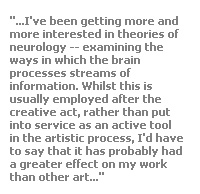
Verhagen :: Probably the most interesting perspective which can effect
my work (or at least the perception of my work once the muse has fled)
comes more from science than art. I’ve been getting more and more
interested in theories of neurology — examining the ways in which the
brain processes streams of information. Whilst this is usually
employed after the creative act, rather than put into service as an
active tool in the artistic process, I’d have to say that it has
probably had a greater effect on my work than other art. The music
which has excited me the most, recently, although probably not
directly “inspirational,” has probably been the recent Dimmu Borghir
and Rammstein albums. (Of course, I’d never admit that in public!)
Igloo :: Now that you’re able to spend more time in the studio, what’s next?
Verhagen :: Most of my studio time over the last few years has been
spent writing scores for dance, theatre, computer games and a bit of
TV. Not too sure whether the amount of studio time will be rising
exponentially though as any minutes salvaged from Dorobo will be
sopped up easily with my teaching commitments at University. I’m
currently working on my live set for the Shinjuku European Tour, am
completing an installation score for the Australian Dance Theatre
(bombastic superhero stuff), the new Patricia Piccinini installation
(contemplative French nature documentary style), and have some film,
computer games and an opera lined up for later in the year. Couldn’t
be happier with the range of soundtracks and interesting people I’m
collaborating with.
::..:::…..:..::….:::::..:::..:::::::……:::…::.:::….::::..:..:::…::…….:::::
EPA :: Black Ice (Dorobo, CD)
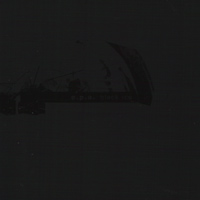
Darrin Verhagen’s final release on his own Dorobo label is the black
slab masterpiece, black | mass, a box set of three releases that span
the wide gamut of sounds and personas that he inhabits. The first
part of the trilogy is Black Ice, a power electronics howl of
Merzbow-ian noise under his EPA guise. Seven tracks spend nearly
forty-five minutes scouring your brain with razor-edged peals of
static and white noise. Obscene monoliths of charged particles lurch
through the wires of your stereo system, coruscating with a nearly
visible discharge of energy. Waves of noise batter against your
tympanic membrane, each impact hammering against your shell until you
burst like a piece of rotten fruit.
“With The Smell of Sulphur” howls and shrieks with irregular pulses
while “With Small Shards of Glass” roars with the undercurrent of
distorted voices as if the combined noises of all the dead are being
funneled into your ear canal through one single pipe. The twelve
minute “With Shredding Rubber” elongates the final seconds before a
car crash into a mutated and distorted squeal of kinetic energy.
Somewhere near the halfway mark, my brain implodes and I start to hear
moments of silence, holes in the sound where echoes of tiny symphonies
live, as if my terrified brain has imposed its own noise gate on the
sound that is busy recreating General Sherman’s infamous March to the
Sea on the tender ganglia of my brain. (And I’m completely sure I’ve
gone deaf in the four seconds of silence at the end of this track.)
Standing shoulder to shoulder with the granddaddies of the genre,
Merzbow and Brighter Death Now, Verhagen’s EPA explores the melodic
fury of white noise, offering an unrequited scream of processed static
and volatile energy to those brave enough to have their ears
lacerated. At high volumes, this record will kill you. At low
volumes, it becomes a white noise generator, a haunted shriek of
compressed sound like a hurricane that has sucked up an entire rock
festival and its 100,000 attendant fans and is churning everything
into a singular mass of focused energy. Black Ice makes you
appreciate the restrained fury of Verhagen’s other works, providing a
cataclysmic counterpoint to the minimal electro-acoustic work under
his own name and the contained cinematic fury of Shinjuku Thief.
::..:::…..:..::….:::::..:::..:::::::……:::…::.:::….::::..:..:::…::…….:::::
Darrin Verhagen :: Black Frost (Dorobo, CD)
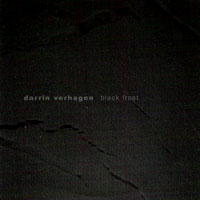
Intended as a slightly uncomfortable antidote to the searing blast of
Black Ice, the tracks of Black Frost are frigid explorations of finely
gradiated tones and glitch elements. Best heard on a heavy pair of
noise-canceling headphones, Black Frost is microtonal music for the
isolation tank, the long distances between stars, and the endless slow
descent into fathomless ocean depths. Changes in the sine tones and
in the miniscule pulses of sound are a delicate symphony for
hummingbirds and bats, sonic chirps and hiccups that occur on such a
fragmentary level as to be nearly invisible. “As Secondary Infection”
is like listening to the sound of crickets trying to whisper and the
minute winds caused by the hum of stars twinkling in the sky.
The central portion of the record is taken up by the 28 minute “/White
Night,” a dose of slowly evolving ambience that hovers like an
intelligent cloud of energized particles and the attendant pair of
scientists who are using several dozen scanning devices to attempt
some sort of analysis of the drifting fog. The scientists talk in
hooded whispers, discussing the readouts on their devices and
scratching their heads at the confusing signals. Meanwhile, the fog
drifts, seemingly without pattern and without purpose in its tiny
propulsive rhythms. As you immerse yourself in the mist, leaving
behind the befuddled scientists, you begin to wonder about the origins
of the minute poly-rhythms and the drifting tones. Which came first?
Which leads? What is the source of their tiny concerto? Like
something off of the Raster-Noton label, “/White Noise” becomes a
chattering cacophony of digital dust, a glitch rhapsody written for
quarks and neutrinos. The final movement of the piece is the
evolution of the single-celled glitch particles into rounded bell
tones, chimes that echo an endless signal against a slumbering
backdrop of gentle sub-sonics.
While the liner notes of Black Ice say that the power noise tracks
were “brutalized” by Verhagen, the note on Black Ice say that the
delicate electro-acoustics herein are “administered” by Verhagen.
These eight lowercase songs are the slow chill of a morphine drip as
the drugs take over your system, cell by cell. There are tiny flashes
of heat as the flesh is numbed, but the sparks hover so close to the
edge of audible perception that they are quickly dissolved in your
imagination.
::..:::…..:..::….:::::..:::..:::::::……:::…::.:::….::::..:..:::…::…….:::::
Shinjuku Thief :: Matte Black (Dorobo, CD)
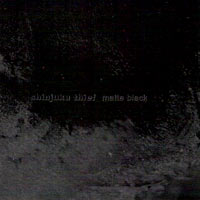
After the shrieking noise of Black Ice, you will think you’ve gone
completely deaf as you attempt to locate the subtle rumblings which
open the Shinjuku Thief portion of the black | mass trilogy. Entitled
Matte Black, the cinematic portion of the set opens with a distant
movement of magma, an inferred rumbling that you feel in the soles of
your feet as if the sound was so heavy that it can’t muster the energy
to climb any higher than your big toe. “..In Time” gives way to the
approaching seismic event of “..In Status,” but the volcanic release
hinted at by the gradual thunder of the subterranean rumbles
approaches slowly. “..In Form” hints at steam vents, spots of
escaping air that bubble with expressed steam, and “..In Line” begins
to show signs of stress.
The whole record is a slow magma push, a sonic soundtrack for a
time-lapse extrusion of molten rock. The penultimate track, “..In
Station,” crackles with escaping energy and jetting steam as the
surface finally starts to tear and splinter with the relentless force
that has been pushing and expanding over the last thirty-five minutes.
Matte Black is a long-form dark ambience piece of approaching
oblivion. And, unexpectedly, it doesn’t erupt. “..In Station” brings
us right to the precipice and backs away, the fire draining back into
the ground.
Why? Because, I think, ultimately this record is the final moment of
the label, the last sound heard in a world gone dark. Promises,
threats, hopes, expectations: they are all sealed away as the light
and heat goes out. This is a record to disappear into, a record that
you should let overwhelm you. Verhagen delicately spells it out in the
liner notes: “in girunt imus nocte et consumimur igni.” Matte Black
won’t blow you away with its massive final eruption; it will devastate
you with the enormity of its restraint.
::..:::…..:..::….:::::..:::..:::::::……:::…::.:::….::::..:..:::…::…….:::::
Darrin Verhagen :: d/classified (Dorobo, CD)
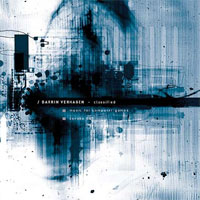
The long-awaited Dorobo 007 (released primarily as a promotional CD
with the black | mass set) is an unreleased video game soundtrack
assembled long before sharp-eyed video game hipsters thought it would
be clever to have Amon Tobin score the latest Splinter Cell game.
Verhagen’s collection of soundtrack music fits in the same covert ops
framework and is a collection of 20 tracks that follow the elusive and
high octane adventure of an unnamed spy. Coupled with attendant notes
(comments like “thematic low-key drama, action:shootout, suspicion/a
dawning realization and aquatic ambience/Stromberg” keep the mood
intact), the music plays out like your own personal espionage
soundtrack.
There’s the James Bond style “Operation Paperclip,” an electronica ‘n’
brass ode to corporate espionage (with a dash of high tech gadgetry
and surreptitious security circumvention); the lost innocence of
“Fourteen Layers of Deceit” as performed by triangle, light electronic
percussion and string section; and the subterranean vault infiltration
done in night vision goggles that is accompanied by brass, strings and
whispered electronics for “Operation Penlight.” The grand ambience of
“Azoic Zone” fills your headspace with the luminous realization of
the Master Plan — the scattered spray of light across the face of the
monolith that will change the face of the world in one swift stroke —
and the electronics twinkle and dapple like falling stars against a
stately percussive rhythm. The action/shootout sequence of “Twelve
Agents” with its percolating drum and bass accelerate into the
frenzied brass section tension of “Time Limit” before, well, you know,
the eventual reversal of fortune through sexy betrayal (“Her
Fingerprint”). The mood turns somber and introspective as events run
through “A False Ending,” “A Break, A Small Lie” and “Ice Fragments”
to the delicate piano and woodwind elegy across wintery ambience of “A
Calm Death.” Is this the end for Secret Agent Man?
Action, danger, misfortune, disaster: the hallmarks of an exciting
spy drama. Verhagen captures it all in personalized sonic glory with
d/classified. Admittedly my life is extremely mundane and the only
espionage I get to perform is sneaking an extra cookie after lunch.
However, with d/classified on my headphones, I am a super spy. Even
if it is just on the inside.
::..:::…..:..::….:::::..:::..:::::::……:::…::.:::….::::..:..:::…::…….:::::
Shinkjuku Thief :: Sacred Fury (Fin de Siecle Media, CD)
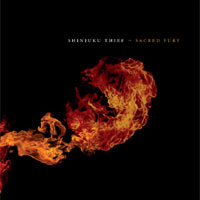
The cinematic theme of Sacred Fury is war and, after the quiet
“Prologue,” the opening of “Lesion” builds like an roaring ball of
fire into an explosive combat zone, dropping the listener into the
center of a war-torn city. A shakuhachi flute haunts the listener
like the last vestiges of rational civilization as everything else
becomes claustrophobic with the proximity of gunfire. While Raised by
Wolves and Medea were much more stringent and bombastic in their chaotic
fury, Sacred Fury is a crippling spiral of despair and destruction.
Events have gone awry, plans have been truly fucked, and while the
narrative voice tries to hold onto a sense of humanity and decency,
the spontaneous cataclysms of war keep intruding.
Monkeys scream and caper in “Black Rope Hell” while crazed bell ringers
and the howl of the wind over a fire-bomed city accompany a tiny
chamber ensemble of melting violins in “Votive Offering.” “Burning
Heat” plunges the listener into one of the Japanese hells populated by
mad Taiko drummers and demented Shinto priests caught up in a bizarre
chant ritual (with Merzbow and a monkey as the officiating priests
just to keep the sonic churn completely overwrought with chaos and
brimstone). “Three Pints of Fluid” is the first breath of air in the
initial twenty minutes of destructive sonic works and its dark
ambience settles over the listener like a miasma of desolation. After
the mortars, the bombs, the fighters and the fire, all that remains is
the shattered husks of the city and the thousands of restless ghosts
that still haunt the ruined streets. You can hear them in the
background like the rustle of dry leaves.
Of course this is only a momentary respite, as the bombast returns
with the symphonic and martial title track. “Sacred Fury” is the
phoenix that rises from the destruction of civilization. Is it
mindless rage bent on revenge — an eye for an eye, a city for a city
— or is there still some humanity — some spark of compassion and
decency — to be found in its black heart? Shinjuku Thief’s Sacred
Fury is a soundtrack of conflict and while there are overt references
to martial combat and strife strewn throughout the record, the
dissipation of the fury in the final ambient moments will leave the
listener to ponder the nature of conflict. Do we create it or do we
find it? Can we leave it behind us? Verhagen’s work, across all his
multi-faceted projects, simply reaches past all the pretension and
noise of our lives and strikes at the tribal and wordless core of our
beings. How do you react to sound? he asks. How do you react to your
world?
::..:::…..:..::….:::::..:::..:::::::……:::…::.:::….::::..:..:::…::…….:::::
Links ::













